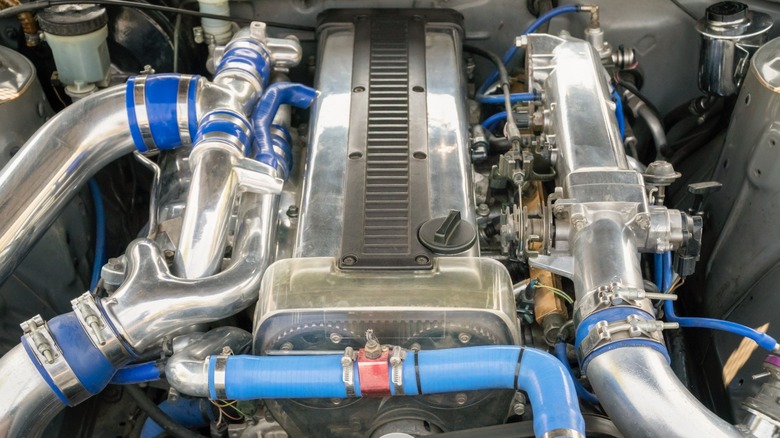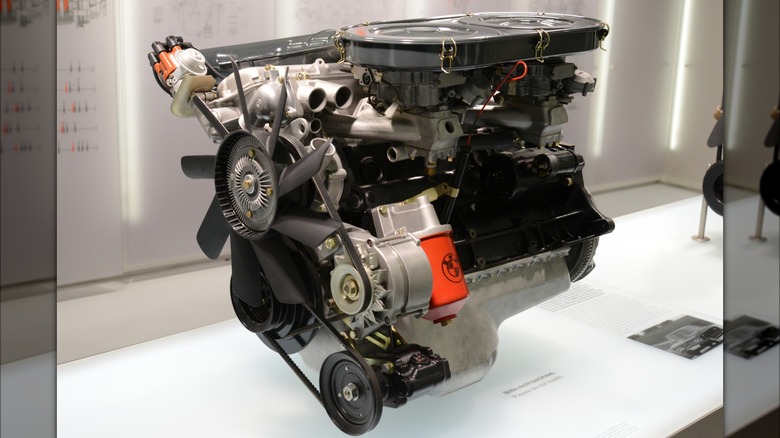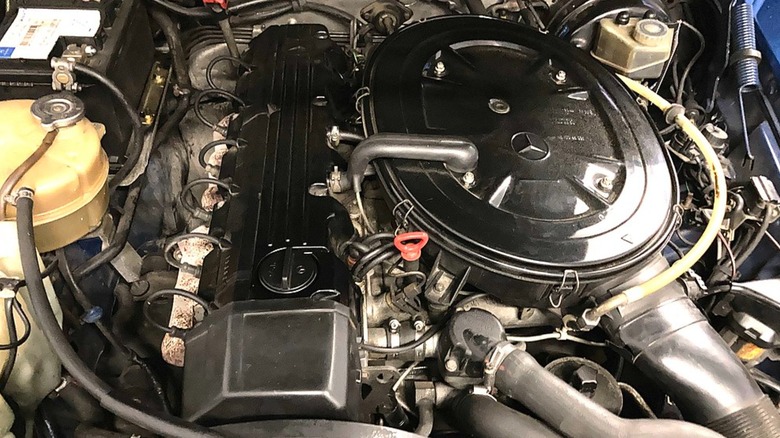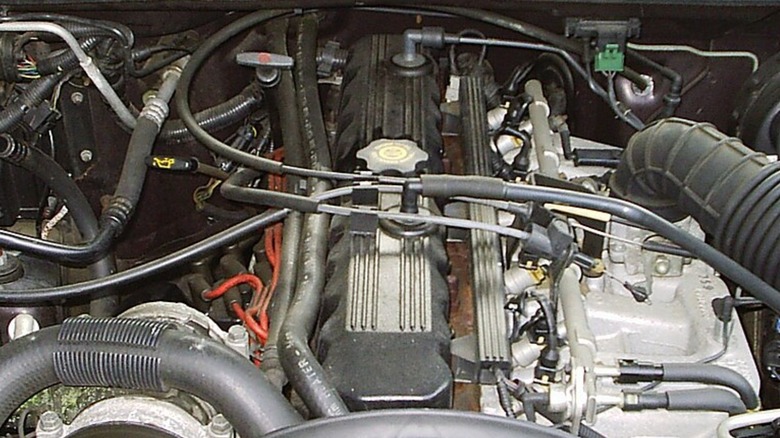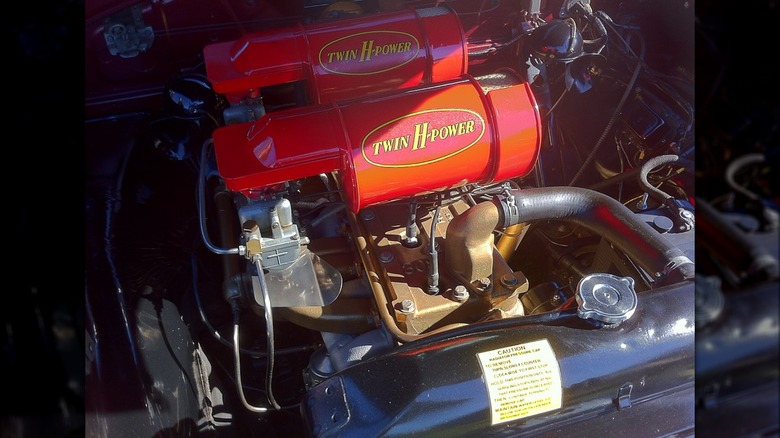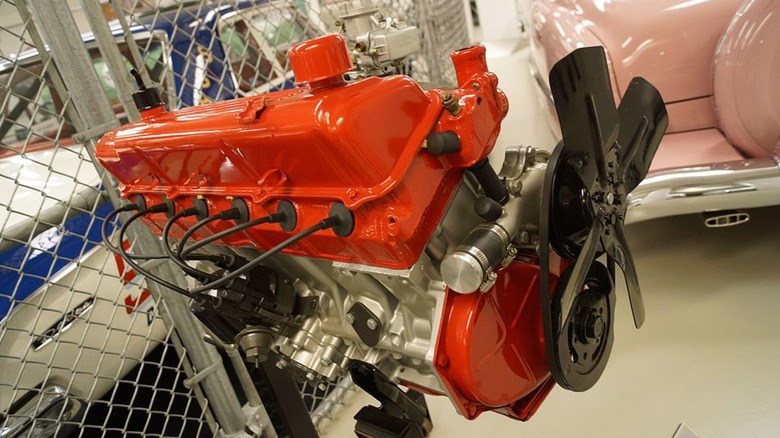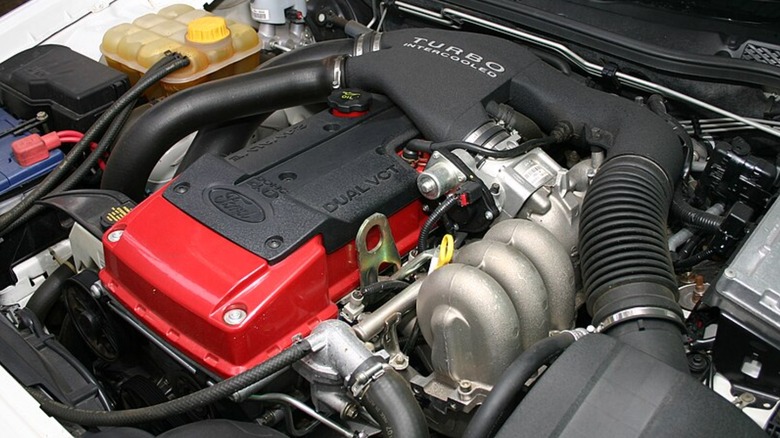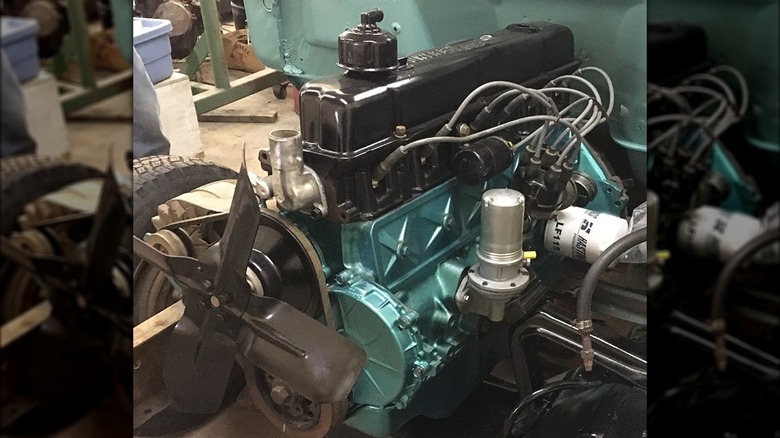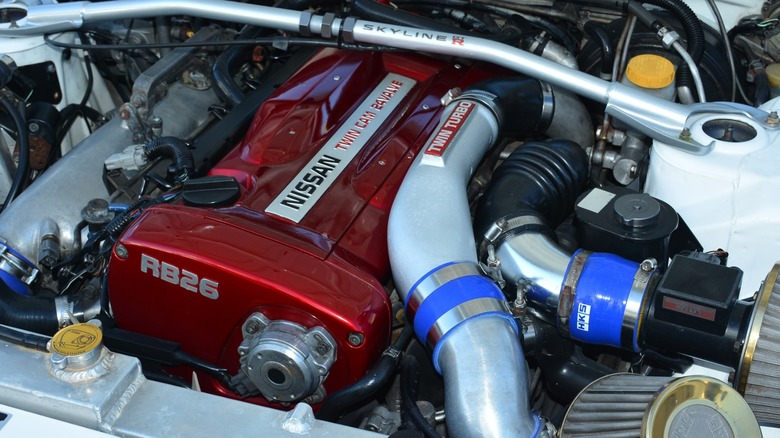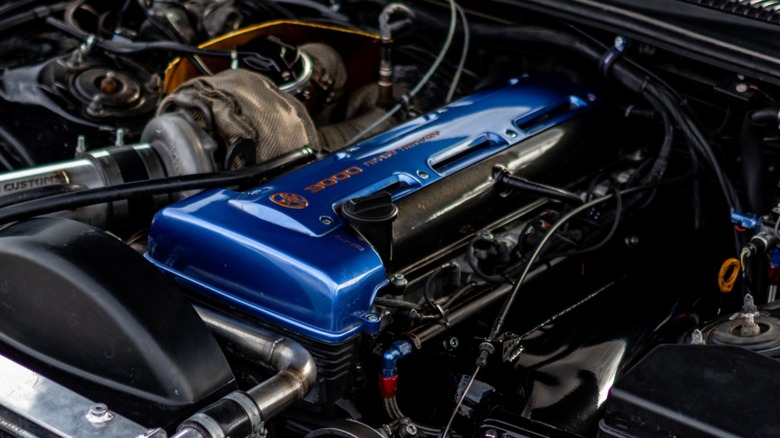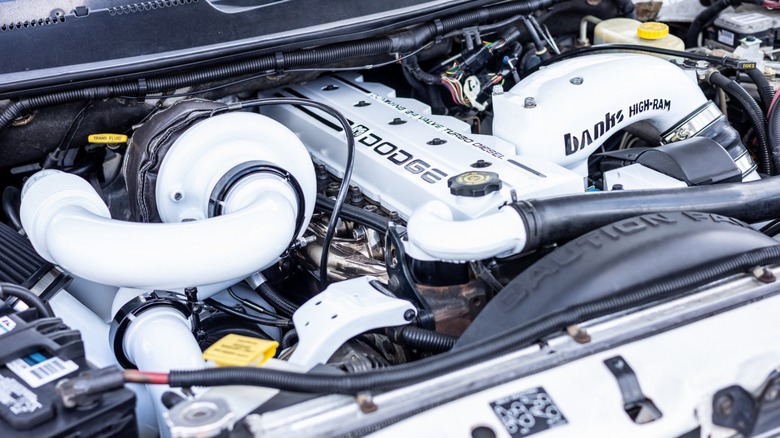The Most Reliable Inline-6 Engines Ever Built, Ranked
The inline-6 engine has been a popular engine design for more than a century and has powered cars of all stripes, from small economy models to exclusive luxury sedans. Although the V8 has long dominated the industry as the best way to package a lot of power in minimal space, inline-6 engines can be made to make power competitive with the V8 while offering a few advantages. Inline engines are less complicated due to the single-cylinder head, which also makes the timing chain assembly less complex. Although a V8 engine allows for a shorter engine compartment, the inline engine offers more room on either side to add accessories such as turbos and superchargers, and they are more inherently balanced and smooth running.
Many of the greatest classic sports cars are powered by a straight-6 engine. Some incredible examples include the Mercedes-Benz 300SL gullwing roadster, the Nissan Skyline GT-R, and the Toyota 2000GT, to name a few. Base model cars in the United States for years were offered with a straight-6 engine — 4-cylinder units were mostly found in imports. The straight-6 engine fell out of favor as the V6 became a popular choice through the '80s and '90s, but recently, there has been a resurgence of companies producing new models, including Mazda, Chrysler, and Mercedes-Benz. This means the last chapter has not yet been written for inline-6. So, let's rank the most reliable examples ever built.
10. BMW M30
BMW has a long history of producing excellent cars powered by straight-6 engines, beginning with the 1934 315/1. This tradition continued into the post-war period, and BMW regained its prominence as a maker of exquisite cars with impeccable engineering. The company released an example of this engineering in 1968 with the M30 inline-6. This new engine was a 2.5-liter with an overhead cam and dual Solex carburetors. With its 9.0:1 compression ratio, it was good for 148 horsepower.
It would soon gain Bosch fuel injection and continue to be produced by BMW for 27 years, an impressive run for any engine. By the time it was retired in 1995, it had grown to 3.5 liters and could be found in some of BMW's most desirable models, including the 1989 Alpina B10 Bi-Turbo, with 360 horsepower.
BMW kept this engine for nearly three decades because it was so well designed to begin with. It proved to be a durable and reliable engine, capable of withstanding modifications to make high levels of horsepower. While the early dual-carburetor setups could cause problems, the Bosch fuel injections, especially the later digital systems, would make fuel delivery precise and trouble-free. Because of its longevity, a large aftermarket performance parts industry continues to support this engine, which is a favorite among classic BMW tuners and racers.
As this engine will require occasional valve adjustments and related maintenance items, some newer BMW inline engines can be operated with less work, but the sophistication can lead to bigger troubles than the robust and reliable M30 straight-6.
9. Mercedes-Benz M103 and M104
Inline-6 engines have always been popular in Europe, and some of Mercedes-Benz's most popular models have used them. The M103 6-cylinder engine originated in the mid-'80s when Mercedes released its legendary W124. The most popular iteration of this chassis was the 300E sedan. This was powered by a 3.0-liter M103 engine featuring an overhead cam and Bosch electronic fuel injection, and the M104 introduced a second camshaft and another set of valves. These cars are well-known for their build quality and longevity, with well-maintained models legendarily racking up hundreds of thousands of miles with relatively little trouble.
The key to the reliability of the M103 is in precision engineering. Mercedes-Benz is a luxury car maker, and before technology provided thousands of added options to install, the company relied on solid build quality with good performance and a silky smooth ride. However, these cars were built with a high degree of complexity, which means they must be maintained regularly. That said, of all the cars you might find from 30-odd years ago with 300,000 miles on the odometer, a 300E is almost certainly to be among them.
[Featured image by Jo664 via Wikimedia Commons | Cropped and scaled | CC BY-SA 4.0]
8. AMC 4.0-liter
American Motors Corporation introduced the 4.0-liter inline-6 engine with the 1987 Jeep Cherokee, Comanche, and Wagoneer just before the Chrysler Corporation took ownership. However, this engine had roots dating back to 1964 when AMC first introduced it as the 3.8-liter Typhoon in 1964. Other variations of smaller displacement were made for various models over the years, culminating in the revised 4.0-liter released in the Cherokee, a smashing sales success for the company at the time. Chrysler retained this engine after the takeover and continued to produce it until 2006, although a Chinese version continued in production until 2012.
The 4.0-liter I6 powered millions of Cherokees and Wranglers, proving to be a tough and reliable engine. It featured fuel injection and two valves per cylinder, making it good for 190 horsepower and 235 pound-foot of torque. While there are bigger and more powerful engines available, the 4.0-liter produced good torque at the low end, which is why Jeep owners loved it so much. Furthermore, it is an uncomplicated engine, which makes it easy and cheap to repair and modify. Some problems arise on these, especially after 100,000 miles, including oil leaks, the most common, as well as some odd noises and coolant leaks. However, the internals are nearly indestructible, and a properly maintained Jeep can easily last 200,000 miles or more.
[Featured image by CZmarlin via Wikimedia Commons | Cropped and scaled | Public Domain]
7. Hudson Twin H-Power
As a company that has been defunct for more than half a century, the name Hudson might not ring many bells for a lot of people. Being included in the "Cars" movie as Doc Hudson has helped to reinvigorate the name. Hudson was a popular brand for many years in America, and the Hornet of the early '50s was a NASCAR legend. Part of what made it great for NASCAR was the Step-Down design with lowered floor plans, which gave it a low center of gravity, and its Twin H-Power straight-6 engine.
During the post-war boom, most automakers put their efforts into bringing new V8 engines to market. Hudson had been struggling for years, so instead of developing a new V8, they re-engineered their existing I6, modified the intake to accept two carburetors, and the Twin H-Power was born. This is a 5.0-liter straight-6 flathead engine that could be tuned to produce up to 210 horsepower with 260 pound-foot of torque.
But the real reason for this engine's success was in NASCAR, where the Hudson Hornet dominated the track, winning 79 races from 1951–55. Power was one reason for its success, but its simplicity of construction and solid reliability is the other reason. No matter how fast your car is, you can't win if the engine breaks down halfway through. Sadly, despite so many successes on the track, Hudson would be discontinued after merging with Nash in 1954. Although the Twin H-Power survived a few more years, Hudsons was only a memory by 1957.
[Featured image by CZmarlin via Wikimedia Commons | Cropped and scaled | Public Domain]
6. Chrysler Slant Six
With a new breed of small cars coming into the market in 1960, Chrysler needed to replace its outdated flathead six with something modern. Its engineers came up with an all-new overhead valve straight-6 with its cylinder bank leaning over by 30 degrees and dubbed it the Slant Six. The slanted packaging proved to be a clever design for a couple of reasons. The slant allowed for a lower hood but also made lots of room for the intake and exhaust on one side. This would make the engines extremely easy to work on and allow engineers to use some of their engineering from Chrysler V8s to create the head and save some time and money.
This engine was never a powerhouse, as it was built for economy models. However, it still produced good low-end torque and could be found in many large models as a base engine until 1983 and in Dodge pickups until 1987. The reason it lasted so long is because it was simple and reliable. Owners were generally happy with their slanted engines as long as they were dependable. Things changed when new emissions laws forced Chrysler to clean it up, and new electronically controlled carburetors proved to be highly problematic, sending customers back to the dealer with multiple problems. This was the end of the Slant Six as new 4-cylinder compacts took over the economy market, heralding the end of an era.
[Featured image by Greg Gjerdingen via Wikimedia Commons | Cropped and scaled | CC BY 2.0]
5. Ford Barra
While the inline-6 left American domestic car production decades ago, the Australians introduced a new one from their division of Ford in 2002. The 4.0-liter dual-overhead cam straight-6 came naturally aspirated with 244 horsepower, although that increased to 322 by 2011 with a turbo variant in the Falcon XR6 Turbo. Even though Australian tuners had a range of V8 engines available to them, the Barra became one of the favorites of Australian tuners and hot rodders. For good reason, the Barra is capable of making tremendous power when set up with the right equipment.
The Barra is another example of an I6 engine that is overbuilt and, in stock form, under-stressed. The beefy components that allow for superior performance provide excellent reliability when not abused. Even though it has been out of production since 2016, the Barra is still a well-respected engine in Australia. Most owners of Falcon XR6 cars report few, if any, problems with the engine, although a few oil leaks have been known to happen. Otherwise, it appears to be as good of an engine as Ford has ever built in either the northern or southern hemisphere. It's too bad it never made its way to any factories in Detroit.
[Featured image by Redback via Wikimedia Commons | Cropped and scaled | Public Domain]
4. Ford 300
Although Ford has been known for its venerable V8 engines, starting with the legendary Ford Flathead, it produced a lesser-known workhorse for decades, the 300 inline-6. Although it shares nearly the same displacement as the popular 5.0 V8, it carries a much different legacy. Found in a range of applications demanding torque and reliability, such as airline tugs and industrial equipment, the 300 I6 is known for offering ample torque at low rpm, with little maintenance needed. It is a robust and heavy iron block and head engine that Ford produced from the '60s through the '90s, and scores of them are still running today.
The Ford 300 never made more than 150 horsepower, even after it received fuel injection. This engine did well, producing up to 260 pound-foot of torque at just 2,000 rpm, which made it perfect for use in trucks and equipment. When geared low enough, it could pull a tree out of the ground without breaking a sweat. Furthermore, the engines are dead simple and easy to repair, and they use timing gears instead of chains, preventing any running issues from a stretched champion or belt. Timing gears can also withstand much more abuse. The Ford 300 may develop oil leaks or exhaust leaks, but with minimal semi-regular maintenance, they will continue to work day after day for decades without a rebuild.
[Featured image by Redeback49 via Wikimedia Commons | Cropped and scaled | CC BY-SA 4.0]
3. Nissan RB26DETT
The engine that powers the legendary Nissan Skyline GT-R is the RB26DETT I6. Although this engine was also installed in the Stagea, its primary purpose was sending gobs of power to the rear wheels of what became known as Godzilla. The bones from which the RB26 was developed are the RB line of engines developed in the '80s and found in an array of Nissan passenger cars, including coupes, sedans, and wagons of all stripes. That was an iron block with an iron head, but the RB26 changed the head to aluminum and added a second camshaft to the mix. The results are impressive.
What makes the RB26 such an impressive engine is that it is overbuilt. The internals are much stronger than they need to be, which is why tuners can squeeze 1,000 horsepower or more out of one. That provides for an engine with low stress when running in its stock form. Low stress leads to reliability, and Nissan's reputation for reliability in the '90s was excellent. The stock RB26 came with dual Garrett turbochargers and was fed via a fuel injection system with six individual throttle bodies, which are not the lowest cost option but offer excellent throttle response.
This was good for 276 horsepower from the dealer when new. Some early versions were known to have problems with the oil pump, a minor design flaw that was later upgraded. Otherwise, few issues tend to come up with one of these so long as it is maintained and hasn't been driven too hard, which may be too tempting to avoid.
2. Toyota 2JZ-GE
The fourth-generation Supra is a '90s automotive icon that has now reached the status of automotive royalty. Well-kept examples with all original parts and reasonably low mileage now sell for an astonishing $200,000, a rarity for any Japanese car from the era. Perhaps the most significant factor that has led to the popularity of these cars is the engine, the Toyota 2JZ. This is a 3.0-liter straight-6 engine with dual cams and dual turbos good for up to 326 horsepower in American and European models — Japanese models were limited to 276 horsepower. At the time, this was as much, or more power, than the American V8 engines were producing in the most popular sports cars available.
Toyota worked hard in the post-war period to build a company with a name synonymous with reliability — and succeeded. The hallmark of a Toyota is that it will rarely need more than an oil change. That is what makes the Supra so alluring, the rarity of having an attractive high-performance car that is not finicky and temperamental. With a Supra, you can get in and have some fun, knowing you will get home and your car will start again the next morning. Furthermore, the over-engineering of the 2JZ means it can be modified to get more than 1,000 horsepower, making it a favorite among import tuners for many years. At the end of the day, it is nearly impossible to go wrong with a 2JZ in any form.
1. Cummins Diesel
Although you won't find it in any car, the Cummins diesel inline-6 has kept Dodge pickups running reliably for decades. This engine first arrived at dealers under the hoods of Dodge full-size pickups in 1989 and proved to be such a good relationship that it still has not ended. When Dodge first started using Cummins engines, it chose a 5.9-liter inline-6 featuring direct fuel injection and a turbocharger. At the time, Dodge was the only automaker to offer a diesel with such specifications, leaving the Ford and Chevy scrambling to catch up. With the Cummins unit, the Dodge Ram came with just 160 horsepower but an impressive 400 pound-foot of torque, making it an attractive option for those with heavy work to be done.
Cummins has been making diesel engines for industrial and agricultural applications since 1909 and has a stellar reputation for making tough and reliable engines. Dodge owners quickly warmed up to the Cummins, coming back for more year after year and solidifying Cummins as a permanent offering for Dodge. Engines were upgraded every few years with new tech and improved specs until the current Cummins diesel offered a 24-valve 6.7-liter unit that produces 370 horsepower and 850 pound-foot of torque, making it strong enough to pull a whole herd of cattle if you wanted to.
Most owners report that a Cummins Dodge is only broken in by 150,000 miles and that the trucks usually wear out long before the engine does, even with 300,000 miles or more. While electric power is a growing part of the automobile industry, heavy-duty work will ensure this diesel will be offered by Ram for many years to come.
